
Mosquitoes are approximately 3,600 species of small flies comprising the family Culicidae. The word "mosquito" is Spanish for "little fly". Mosquitoes have a slender segmented body, one pair of wings, one pair of halteres, three pairs of long hair-like legs, and elongated mouthparts.

Aedes albopictus, from the mosquito (Culicidae) family, also known as the (Asian) tiger mosquito or forest mosquito, is a mosquito native to the tropical and subtropical areas of Southeast Asia. In the past few centuries, however, this species has spread to many countries through the transport of goods and international travel. It is characterized by the white bands on its legs and body.

Mosquito control manages the population of mosquitoes to reduce their damage to human health, economies, and enjoyment. Mosquito control is a vital public-health practice throughout the world and especially in the tropics because mosquitoes spread many diseases, such as malaria and the Zika virus.
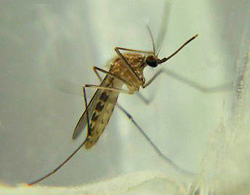
Culex or the typical mosquitos are a genus of mosquitoes, several species of which serve as vectors of one or more important diseases of birds, humans, and other animals. The diseases they vector include arbovirus infections such as West Nile virus, Japanese encephalitis, or St. Louis encephalitis, but also filariasis and avian malaria. They occur worldwide except for the extreme northern parts of the temperate zone, and are the most common form of mosquito encountered in some major U.S. cities, such as Los Angeles.

Culex pipiens, commonly referred to as the common house mosquito, is a species of mosquito. House mosquitoes are some of the most common mosquitoes. More specifically, Culex pipiens is considered as the northern house mosquito, as it is the most common mosquito to the northern regions of the US. North of the 39th parallel north in the US, only C. pipiens are present, whereas south of the 36th parallel north, only C. quinquefasciatus are present. Additionally, they can be found in both urban and suburban temperate and tropical regions across the world.
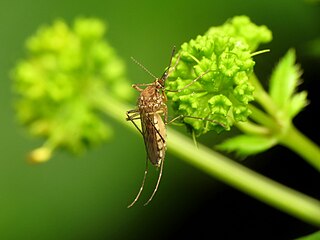
Aedes vexans, the inland floodwater mosquito or tomguito, is a cosmopolitan and common pest mosquito. This species has been collected in southern California.

Culex annulirostris, commonly known as the common banded mosquito, is an insect native to Australia, Fiji, Micronesia, the Philippines and Indonesia. It is regarded as a serious pest species throughout its range.

Aedes triseriatus is a member of the true fly order. It is called the eastern tree hole mosquito due to its predilection towards breeding in stagnant water that is found in natural holding containers such as tree holes. It is native to the eastern United States and southern Canada and favors hardwood habitats. It has been found as far south as the Florida Keys, as far west as Idaho and Utah, and as far north as Quebec and Ontario. This species has not yet been found in Europe, but it has the potential to spread through international trade. In 2004, it was found in a shipment of tires travelling from Louisiana to France, but it was identified and targeted with insecticides that truncated its spread. It is a known vector of La Crosse encephalitis and canine heartworm disease. In the laboratory, it has been found to vector several other viruses including yellow fever, eastern encephalitis, Venezuelan encephalitis, and western encephalitis. Because of its potential for international spread and its proclivity for transmitting disease, monitoring the distribution of this species is essential.

Culex quinquefasciatus, commonly known as the southern house mosquito, is a medium-sized mosquito found in tropical and subtropical regions of the world. It is a vector of Wuchereria bancrofti, avian malaria, and arboviruses including St. Louis encephalitis virus, Western equine encephalitis virus, Zika virus and West Nile virus. It is taxonomically regarded as a member of the Culex pipiens species complex. Its genome was sequenced in 2010, and was shown to have 18,883 protein-coding genes.
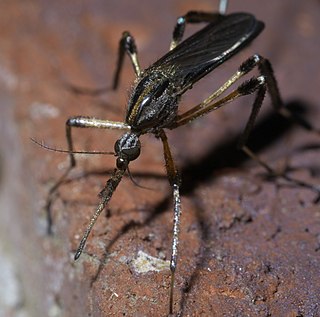
Psorophora ciliata is a species of large mosquito indigenous to the United States east of the continental divide. It is one of thirteen species of the genus that reside in the continental United States. The mosquito has been referred to as the “gallinipper” or “shaggy-legged gallinipper” due to its tendency for aggressive behavior.

Aedes canadensis, the woodland pool mosquito, is an aggressive, day biting mosquito that can be a vector of a number of diseases which is found mainly in eastern North America.

Coquillettidia perturbans is a species of mosquito that have been documented in every continent except Antarctica. This mosquito is a known as a vector of West Nile virus and Eastern equine encephalomyelitis. The geographic range of C. perturbans is increasing due to the growing extensity of the feeding area. They are known to exist throughout the United States, mainly with a southern distribution, and are mammalophilic.
Aedes africanus is a species of mosquito that is found on the continent of Africa with the exclusion of Madagascar. Aedes aegypti and Aedes africanus are the two main yellow fever vector species in Zambia. Aedes africanus is mainly found in tropical forests not near wetlands.
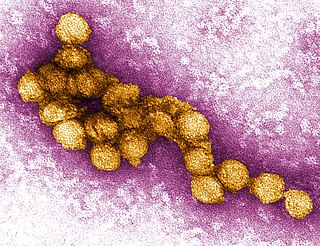
West Nile virus (WNV) is a single-stranded RNA virus that causes West Nile fever. It is a member of the family Flaviviridae, from the genus Flavivirus, which also contains the Zika virus, dengue virus, and yellow fever virus. The virus is primarily transmitted by mosquitoes, mostly species of Culex. The primary hosts of WNV are birds, so that the virus remains within a "bird–mosquito–bird" transmission cycle. The virus is genetically related to the Japanese encephalitis family of viruses. Humans and horses both exhibit disease symptoms from the virus, and symptoms rarely occur in other animals.
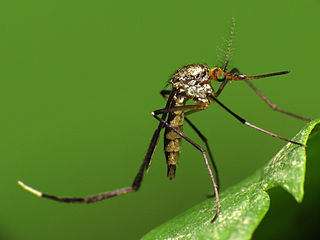
Psorophora ferox is a medium-sized mosquito native to much of North and South America. It inhabits wet woodlands, laying its eggs in temporary pools filled with rainwater. Larvae develop during summer in North America. They are aggressive feeders and give painful bites. The mosquito is reported to be active during both day and night.

Climate change in Colorado encompasses the effects of climate change, attributed to man-made increases in atmospheric carbon dioxide, in the U.S. state of Colorado.

Anopheles freeborni, commonly known as the western malaria mosquito, is a species of mosquito in the family Culicidae. It is typically found in the western United States and Canada. Adults are brown to black, with yellow-brown hairs and gray-brown stripes on the thorax. Their scaly wings have four dark spots, which are less distinct in the male.

Opifex fuscus, known commonly as the saltpool mosquito or by its Māori name naeroa, is an endemic mosquito that is widespread along the coast of New Zealand.

Aedes taeniorhynchus, or the black salt marsh mosquito, is a mosquito in the family Culicidae. It is a carrier for encephalitic viruses including Venezuelan equine encephalitis and can transmit Dirofilaria immitis. It resides in the Americas and is known to bite mammals, reptiles, and birds. Like other mosquitoes, Ae. taeniorhynchus adults survive on a combination diet of blood and sugar, with females generally requiring a blood meal before laying eggs.

Aedes infirmatus, informally referred to as the infirm American pointy mosquito or silverback mosquito, is a species of mosquito that is found in woodland environments in parts of Central America, Mexico, and the southern United States, with a type locality in Baton Rouge, Louisiana. In the United States, they have been found as far west as Texas and as far north as New Jersey.



















